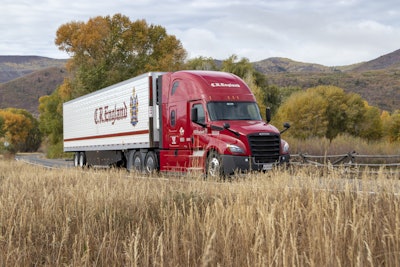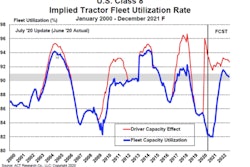 C.R. England used technology to replace face-to-face driver meetings, which enabled the company to reach more drivers and respond more quickly to their needs, said T.J. England, the company’s chief legal officer.
C.R. England used technology to replace face-to-face driver meetings, which enabled the company to reach more drivers and respond more quickly to their needs, said T.J. England, the company’s chief legal officer.The coronavirus pandemic has thrown the entire world into upheaval and forced many industries to reinvent themselves and how they conduct business.
Demand for consumer staples was booming this spring as countless businesses were shuttered and an economic tailspin plagued industries supported by discretionary spending. Meanwhile, trucking was brought to a crossroads between hands-on driver safety and the emerging reality of having to do business in a virtual world.
C.R. England (CCJ Top 250, N0. 23) Chief Legal Officer T.J. England said the Salt Lake City, Utah-based company’s management team got aggressive in February planning for what would eventually become widespread shutdowns, including shifting to a comprehensive work from home labor force.
“If you were to ask me prior to the pandemic if we could pull this off, I would probably say we couldn’t,” he said, adding the carrier ultimately was able to transition more than 1,000 people to working from home.
Despite a strong start to 2020, Sherri Garner Brumbaugh, president and CEO of Findlay, Ohio-based truckload carrier Garner Trucking and American Trucking Associations Chairwoman, said it became obvious early on that COVID was going to be a major disruptor, adding “it became clear that people across the country are getting sick.”
Garner Trucking began seeking out information that could be shared with drivers and staff on how they could protect themselves and worked to deploy a playbook that would become an ongoing work in progress.
“It was nerve-racking,” she said, adding that the company’s human resources director starting writing policies and procedures for face coverings and temperature taking, all while helping drivers find PPE and getting them pertinent information.
Complicating matters, said America’s Road Team Captain and UPS Freight driver John McKown, was that many state-sponsored rest areas were closed, and restaurants that weren’t closed were limited, making finding a place to stop and eat, take mandated breaks, sleep or even use the restroom almost impossible – all while supply chains were stressed to levels mostly reserved for natural disasters and begging for trucking’s help.
“This was like 20 hurricanes all at the same time,” said Joe Metzger, Walmart senior vice president of transportation. “In early March we saw a run on consumables like paper products and hand sanitizer, and just a few weeks later we had a significant run on our grocery business.”
Now eight months into a pandemic, focus shifts from survival mode to thriving in this extended “new-normal.”
Admittedly, England said he had an “overly rosey” outlook on the virus in early spring and expected life mostly to return to normal by the end of the year. Just two months from year’s end and no end in sight, England said the company took advantage of the weaknesses the pandemic exposed.
“We’ve shaken loose a whole lot of our old habits and re-thought how to move forward in a quicker more efficient fashion,” he said. “Hopefully this ‘new normal’ doesn’t last forever, but hopefully the things that we’ve learned from it, they do.”
C.R. England used technology to replace face-to-face driver meetings, which England said enabled the company to reach more drivers and respond more quickly to their needs.
“We felt that we had good communication with our drivers, but we really had to step it up and communicate more often,” added Brumbaugh. Drivers wanted to know how the company was going to handle needs of its employees and its customers at the onset of the pandemic, so the company deployed weekly updates from department managers, including the finance department who laid bare the company’s overall fiscal health and the maintenance and safety departments who offered updates on how they are keeping trucks safe and sanitized.
“It wasn’t flashy. It wasn’t studio,” she said. “It was an iPhone in the lobby of our operations [but] the drivers really, and our staff, they looked forward to those.”
Similarly, Metzger said his team realized the world’s second largest retailer was going to have to be more proactive and responsive when it came to moving its goods, and by the second week of March initiated a daily stand up meeting with department leaders.
“But it wasn’t about business,” he said. “It was about ‘what can we do to help the driver?’ Every day was learnings coming from the field and it didn’t take ‘we’ll get back to you in two months.’ We were making decisions on the spot, not worrying about if it’s going to cost a penny here or a penny there. It was ‘do whatever it takes so we can take care of our drivers and make sure we’re taking friction out and getting the flow of goods where they need to be.'”
The standup meetings continued through early September, “where we felt we now have enough standard work built from everything we’ve learned that’s not going away,” Metzger said. “I think there was a servant leadership aspect that we’ve all become much better at. We still have a long way to go, but I really think that was a positive. We’re quicker, faster [and] making better decisions.”
The effects of the pandemic will likely be felt for many months to come, as the temporary closure of certain services – the Department of Motor Vehicles, for example – continues to be a drag on recovery.
“[Closing DMVs nationwide] was a crisis at first and now it just continues to be a lingering challenge for us,” England said. “We still have problems getting drivers permitted and tested,” England added. “Many DMVs in many states have 90 day delays in order to schedule an appointment, and if you think about folks who are trying to change a career or start a new career, if you tell them they they can’t actually get started for 90 days, can’t start earning money for at least 90 days, they’re going to go find something else.”
A perceived driver shortage is the top issue facing the industry for the fourth consecutive year, according to the American Transportation Research Institute’s annual Top 10 Trucking Industry Issues survey. C.R. England and other large companies that operate driving schools have had to close down their classrooms.
“Part of [the driver shortage] absolutely has to do with that we can’t get new folks in and trained and moving,” England added.










